One of the most common tasks in web development is to determine which HTTP verb your visitor has used to request a page. Is this an initial GET request, or has the user POSTed a form? In classic ASP or PHP, you will usually query the Server Variables collection (Request.ServerVariables("REQUEST_METHOD") or $_Server['REQUEST_METHOD']) to determine which verb was used, or you might query the Request.Form collection for the presence or absence of values. The ASP.NET Web Forms and Web Pages frameworks provide convenience methods to differentiate between POST and GET requests via the Page.IsPostBack and Page.IsPost properties respectively. ASP.NET MVC offers a different solution, mapping information from the request - the URL and the HTTP verb - to controller actions using a convention-based approach.
Handler methods in Razor Pages are also based on naming conventions. The basic methods work by matching HTTP verbs used for the request to the name of the method, and they are prefixed with "On": OnGet(), OnPost(), OnPut() etc. They also have asynchronous equivalents: OnPostAsync(), OnGetAsync() etc. The following example illustrates basic usage in a single Razor pages file:
@page @{ @functions{ public string Message { get; set; } public void OnGet() { Message = "Get used"; } public void OnPost() { Message = "Post used"; } } } <h3>@Message</h3> <form method="post"><button class="btn btn-default">Click to post</button></form> <p><a href="/handlerexample" class="btn btn-default">Click to Get</a></p>
When the page is first navigated to, the "Get used" message is displayed because the HTTP GET verb was used for the request, firing the OnGet() handler.
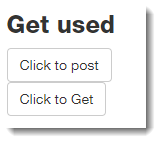
When the "Click to post" button is pressed, a form is posted and the OnPost() handler fires, resulting in the "Post used" message being displayed.
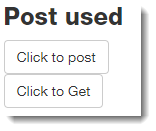
The button underneath is a hyperlink, which initiates a GET request, resulting in the "Get used" message being displayed once more.
Named Handler Methods
Imagine that you have a number of forms on the page (perfectly legal everywhere except Web Forms...) - how will you know which one was submitted? Well, I kind of take a bit if an unfair dig at Web Forms, but in fact the solution to the problem is not too disimilar to Web Forms button click event handlers. Razor Pages introduces named handler methods. The following code shows a collection of named handler methods declared in a code block at the top of a Razor page (although they can also be placed in the PageModel class if you are using one):
@page @{ @functions{ public string Message { get; set; } = "Initial Request"; public void OnGet() { } public void OnPost() { Message = "Form Posted"; } public void OnPostDelete() { Message = "Delete handler fired"; } public void OnPostEdit(int id) { Message = "Edit handler fired"; } public void OnPostView(int id) { Message = "View handler fired"; } } }
The convention (in Preview 1) is that the name of the method is appended to "OnPost" or "OnGet". The next step is to associate a specific form action with a named handler. This is achieved by setting the asp-page-handler attribute value for a form taghelper:
<div class="row"> <div class="col-lg-1"> <form asp-page-handler="edit" method="post"> <button class="btn btn-default">Edit</button> </form> </div> <div class="col-lg-1"> <form asp-page-handler="delete" method="post"> <button class="btn btn-default">Delete</button> </form> </div> <div class="col-lg-1"> <form asp-page-handler="view" method="post"> <button class="btn btn-default">View</button> </form> </div> </div> <h3 class="clearfix">@Model.Message</h3>
The code above renders as three buttons, each in their own form along with the default value for the Message property:
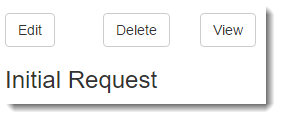
The name of the handler is added to the form's action as a querystring parameter:
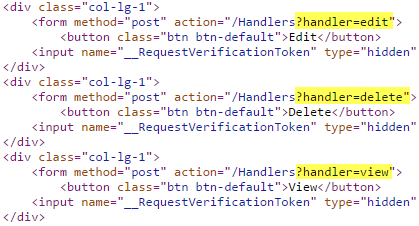
As you click each button, the code in the handler associated with the querystring value is executed, changing the message each time.
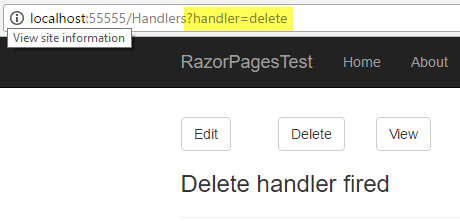
If you prefer not to have querystring values in the URL, you can use routing and add an optional route value for "handler" as part of the @page directive:
@page "{handler?}"
The name of the handler is then appended to the URL:
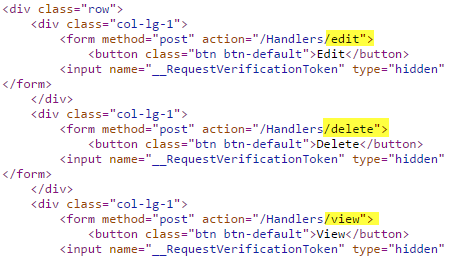
Parameters
Handler methods can be designed to accept parameters:
public void OnPostView(int id) { Message = $"View handler fired for {id}"; }
The parameter name must match a form field name for it to be automatically bound to the value:
<div class="col-lg-1"> <form asp-page-handler="view" method="post"> <button class="btn btn-default">View</button> <input type="hidden" name="id" value="3" /> </form> </div>
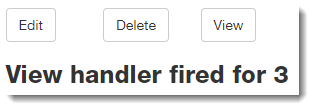
Alternatively, you can use the form tag helper's asp-route attribute to pass parameter values as part of the URL, either as a query string value or as route data:
<form asp-page-handler="delete" asp-route-id="10" method="post"> <button class="btn btn-default">Delete</button> </form>
You append the name of the parameter to the asp-route attribute (in this case "id") and then provide a value. This will result in the parameter being passed as a querystring value:

Alternatively, you can extend the route defintion for the page to account for an optional parameter:
@page "{handler?}/{id?}"
This results in the parameter value being added as a separate segment in the URL:

Summary
Razor Pages handler methods facilitate the clear separation of processing code based on user actions on the page without resorting to a confusing pile of conditional code to determine which button was clicked. They follow a clear naming convention and are easy to use. When placed in a code-behind file, they can make the page feel very much like an MVC controller. They can also be seen as analogous to event handlers in a Web Form code behind file.
